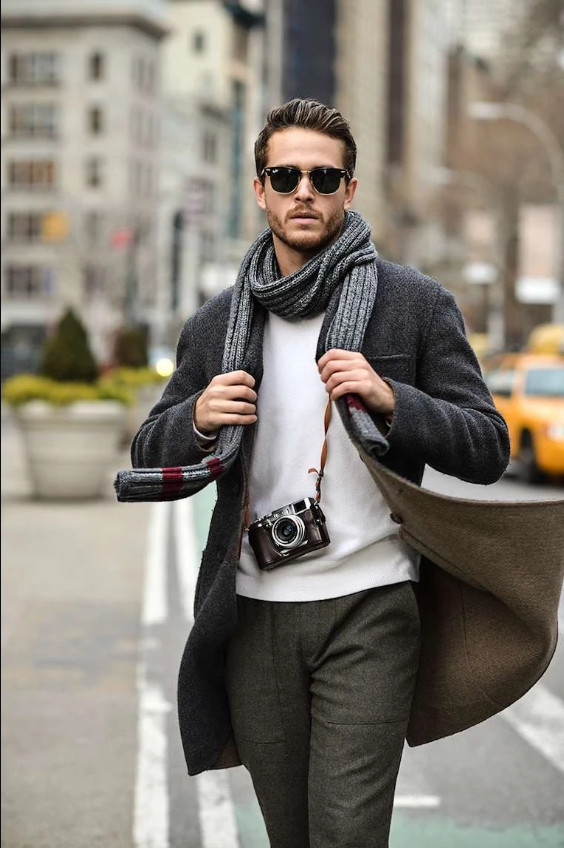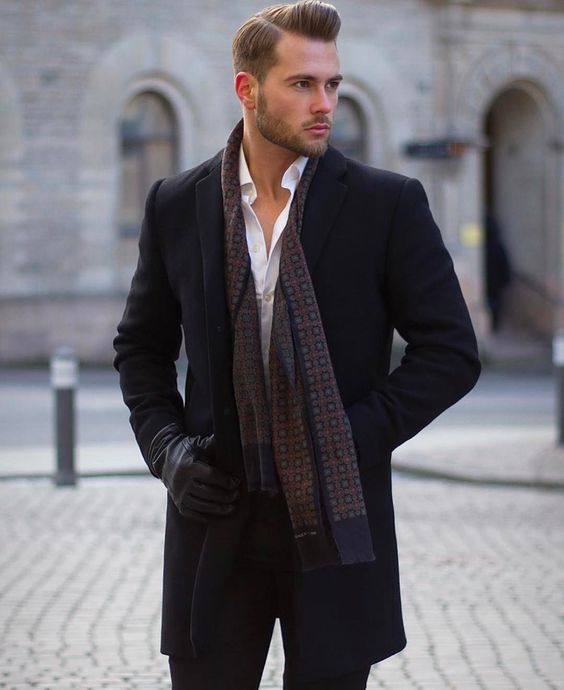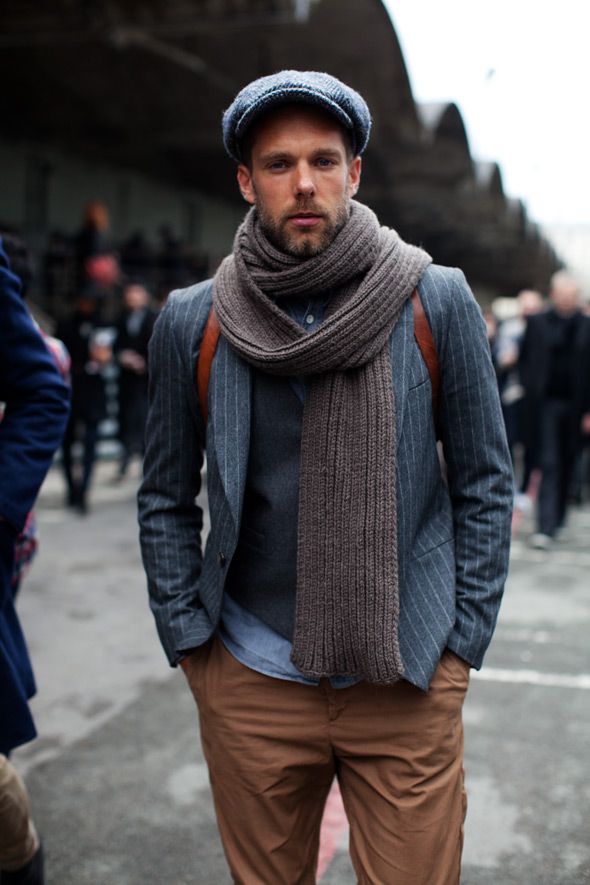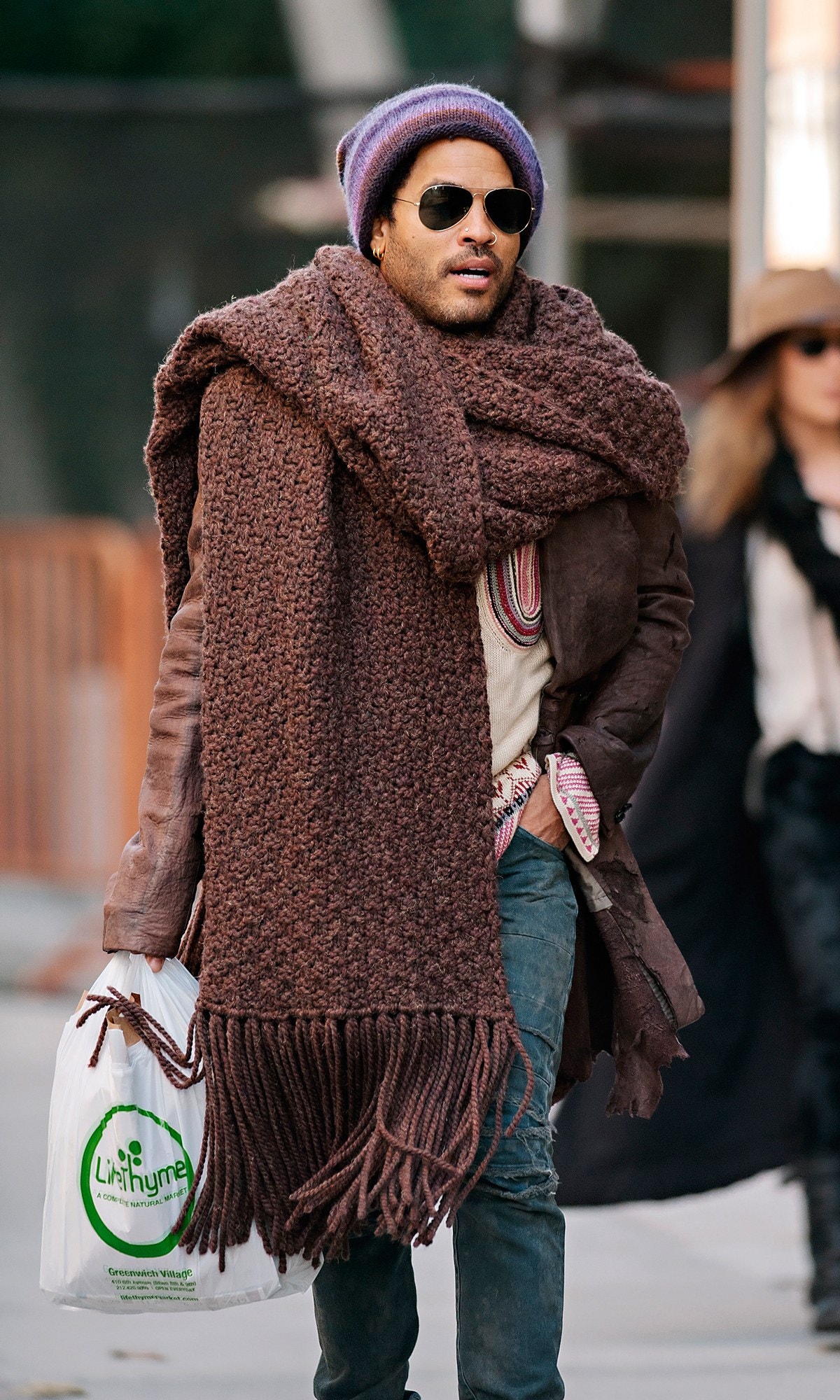

15 Photos
Scarves have too long been thought of as something only girls wear, but the truth is scarves were brought into the common clothing accessory by men. Today, we are going to be discussing how to wear a scarf for Guys. These tips will help you raise your fashion level up a notch and definitely make you stand out. But before we begin, let’s talk about the history of scarves.
History of Scarves


Scarves have been a staple in men’s wardrobes for over 2000 years, with the world’s militaries using them as rank insignia and unit designators. From the Terracotta Warriors of China to modern-day desert military units, we see scarves used because they provide value in inclement weather. Look at photos of the world’s greatest military aviators or soldiers fighting in the Battle of the Bulge, and you’ll see lots of scarves and nary a girly man in sight.
100 years ago, when open cockpits were standard, pilots wore a silk scarf around their neck to keep warm and prevent chafing. For thousands of years, militaries have used them to differentiate soldiers. From what battalions & regiments you belonged to, what your specific duties were in combat.
Today, wool, cashmere, and even synthetic scarves are used for their ability to insulate the neck while providing freedom of movement.
Scarves are a great accessory when you want to make your outfit look a bit more sophisticated. Fashion icons like Tom Ford can always be seen wearing a scarf with their suits. Popular singer Harry Styles also went through a phase where he rocked the scarf look.
General Rules
- Keep it simple – only tie knots you are comfortable wearing–confidence is everything.
- Scarf length & thickness can limit knot style options.
- A scarf isn’t a necktie–keep it loose.
- Function first–fashion second.
How to Wear a Scarf for Guys. 5 ways to wear a scarf.
The Drape


The Drape leans more towards style rather than function. You don’t tie the scarf at all – but it’s a great way to add a dash of color to your drab overcoat and draw attention to your face.
A scarf drape is best for when the weather is cool, but not cold. As the name implies, just drape the scarf over your neck, equal lengths on each side, and don’t tie it – you’re good to go.
The scarf drape works best with a short to regular-length scarf.
Once around


With the Once Around, you still don’t really tie the scarf, but it provides more warmth around the neck than the scarf drape, and so can be worn in colder weather. Start by draping the scarf around your neck, making one end longer than the other.
Take the long end of the scarf and bring it around your neck, and you’re done – no need to tie a knot. The ends of the scarf can either be equal length or uneven – it’s really up to the wearer’s preference.
The Repeated Loop


This repeated loop scarf knot is the best choice for freezing weather, next to the Four in Hand, but it is much simpler to tie. Again, it will work best if you are using a longer scarf.
Drape the scarf over your neck, making one end much longer than the other. Take the long end of the scarf and wrap it around your neck, then repeat again, bringing it around your neck a second time. This is another knot where you don’t really tie the scarf.
Adjust the scarf if needed to completely cover your neck, and you are all set for whatever the winter weather has in store for you.
Overhand Knot


This scarf knot is very simple to tie, looks clean and functional, and provides good protection to the neck in cool weather.
Drape the scarf around your neck, making one end longer than the other. Take the long end of the scarf, cross it over the short end, then bring it under and through the opening near your neck to tie.
After you tie the knot, pull on both ends of the scarf to tighten it until you are satisfied with the look. I think this scarf knot looks best when one end is slightly longer than the other.
The “Parisian” or French or European Knot


A very classy looking way to tie a scarf, this scarf knot provides good warmth to the neck and is a good choice in colder weather.
Fold your scarf in half widthwise, then fold in half again lengthwise.
Drape the scarf over your neck, and then bring the loose ends through the hole formed by the folded end to tie the knot. Tighten the scarf around your neck and you’re ready to go.
Choosing the Right Scarf Material
When selecting a scarf, material matters—not only for comfort and warmth but also for style versatility and durability. The best scarf fabrics for men balance function, aesthetics, and occasion-specific use. Below are the top choices categorized by use-case, climate, and texture preference:
1. Wool – The Classic Cold-Weather Staple
Best for: Fall & winter, formal and casual wear
Wool scarves are timeless, durable, and highly insulating. They retain heat well, making them ideal for colder climates. Merino wool is especially popular for its soft texture and natural moisture-wicking properties, while lambswool offers a slightly thicker, rugged appeal.
Pros: Excellent warmth, breathable, moisture-resistant
Cons: Some blends may feel itchy without a soft lining
2. Cashmere – Luxury in Lightweight Form
Best for: Cold-weather sophistication, business attire
Cashmere is derived from the undercoat of cashmere goats and is known for its unparalleled softness, warmth, and lightweight feel. It offers an elegant drape that works seamlessly with overcoats and tailored blazers, making it a preferred choice for refined styling.
Pros: Ultra-soft, lightweight yet warm, luxury look
Cons: Premium price point, requires delicate care
3. Cotton – Breathable and Year-Round Friendly
Best for: Mild weather, spring/fall layering
Cotton scarves offer versatility across seasons and are ideal for men who prefer natural, breathable fibers. They come in a range of weaves and weights—from lightweight gauze to dense twill—making them suitable for layering or as a subtle accessory.
Pros: Breathable, low maintenance, hypoallergenic
Cons: Not as warm for winter use
4. Linen – Lightweight for Warm Climates
Best for: Summer styling, tropical and arid regions
Linen scarves provide a crisp, relaxed aesthetic with strong moisture-wicking and quick-drying capabilities. Perfect for coastal or humid environments, they pair well with casual and resort wear.
Pros: Light, breathable, stylish texture
Cons: Prone to wrinkling, minimal insulation
5. Alpaca – Warm, Soft, and Hypoallergenic
Best for: Cold weather with skin sensitivity concerns
Alpaca wool offers warmth comparable to cashmere but with more durability and hypoallergenic qualities. It’s a strong choice for those with wool sensitivities who still want a luxe winter scarf.
Pros: Soft, non-irritating, thermally efficient
Cons: Less common, slightly stiffer drape than cashmere
6. Synthetic Blends – Performance and Budget-Friendly
Best for: Everyday use, travel, or activewear
Polyester, acrylic, and modal blends mimic natural fibers at a more affordable price. Many modern scarves use synthetic blends to increase durability, color retention, and wrinkle resistance.
Pros: Affordable, wrinkle-resistant, easy to clean
Cons: Less breathable, can feel less natural
Styling Scarves for Different Outfits & Occasions
Wondering how to match scarves with your wardrobe? Here’s a quick breakdown:
- With a Suit or Blazer: Opt for a slim wool or silk scarf using a Parisian or Drape style. Keep colors muted or match your tie/pocket square.
- With a Casual Jacket or Leather Coat: Go for the Once Around or Repeated Loop using cotton or chunky knits.
- With Layered Streetwear: Oversized scarves work well. Use neutral or earth tones for versatility.
- Formal Events: Stick to dark, solid colors and fine fabrics like cashmere or silk. Drape or Parisian knot recommended.
Tip: Avoid patterns when wearing patterned jackets or shirts—balance is key.
How to Care for Your Scarf?
Caring for scarves requires an approach tailored to both the material and the wearer’s intent to maintain texture, shape, and color integrity over time. Whether the scarf is silk, wool, cashmere, or cotton, the foundational care routine centers on gentle cleansing, moisture control, and proper storage. Below is a structured, material-respectful guide to scarf maintenance:
Washing Guidelines
1. Prioritize Hand Washing
Hand washing is the safest method for most scarves, particularly delicate fabrics like silk, wool, or cashmere. Use lukewarm water and a mild, pH-neutral detergent. Avoid fabric softeners or bleach, which can degrade fibers.
2. Gentle Agitation Only
Submerge the scarf and swirl it gently to loosen any dirt. Do not scrub, wring, or twist the fabric, as this can distort the weave or cause permanent stretching.
3. Rinse Thoroughly
Use cold water to rinse until all detergent residue is gone. Soap traces left behind can attract dust and weaken fabric over time.
4. Remove Water Carefully
Place the scarf on a clean, absorbent towel. Roll the towel (with the scarf inside) to extract excess moisture without applying stress to the fabric.
Drying Protocols
1. Lay Flat to Dry
Place the scarf flat on a dry towel or mesh rack in a shaded, well-ventilated area. Avoid direct sunlight, which can fade dyes and weaken natural fibers.
2. Never Hang to Dry
Hanging can lead to stretching, especially in loosely woven or delicate fabrics. Gravity may distort the original shape of the scarf.
3. Ironing Tips (If Needed)
If your scarf requires pressing, use a low-heat setting and always place a cotton cloth between the iron and the scarf. Steam settings are preferable for wool and silk to avoid scorching or shine marks.
Storage Best Practices
1. Cool, Dry, Breathable Storage
Store scarves in a breathable fabric bag or loosely wrapped in acid-free tissue paper. Avoid plastic bags, which can trap moisture and promote mildew or fabric degradation.
2. Avoid Folding Along Sharp Creases
For long-term storage, roll the scarf gently or fold it loosely to avoid hard creases that can damage the fabric over time.
3. Protect from Moths and Odors
For wool or cashmere, consider cedar blocks or lavender sachets to deter moths. Ensure the scarf is completely dry before storing to avoid mildew or musty smells.















